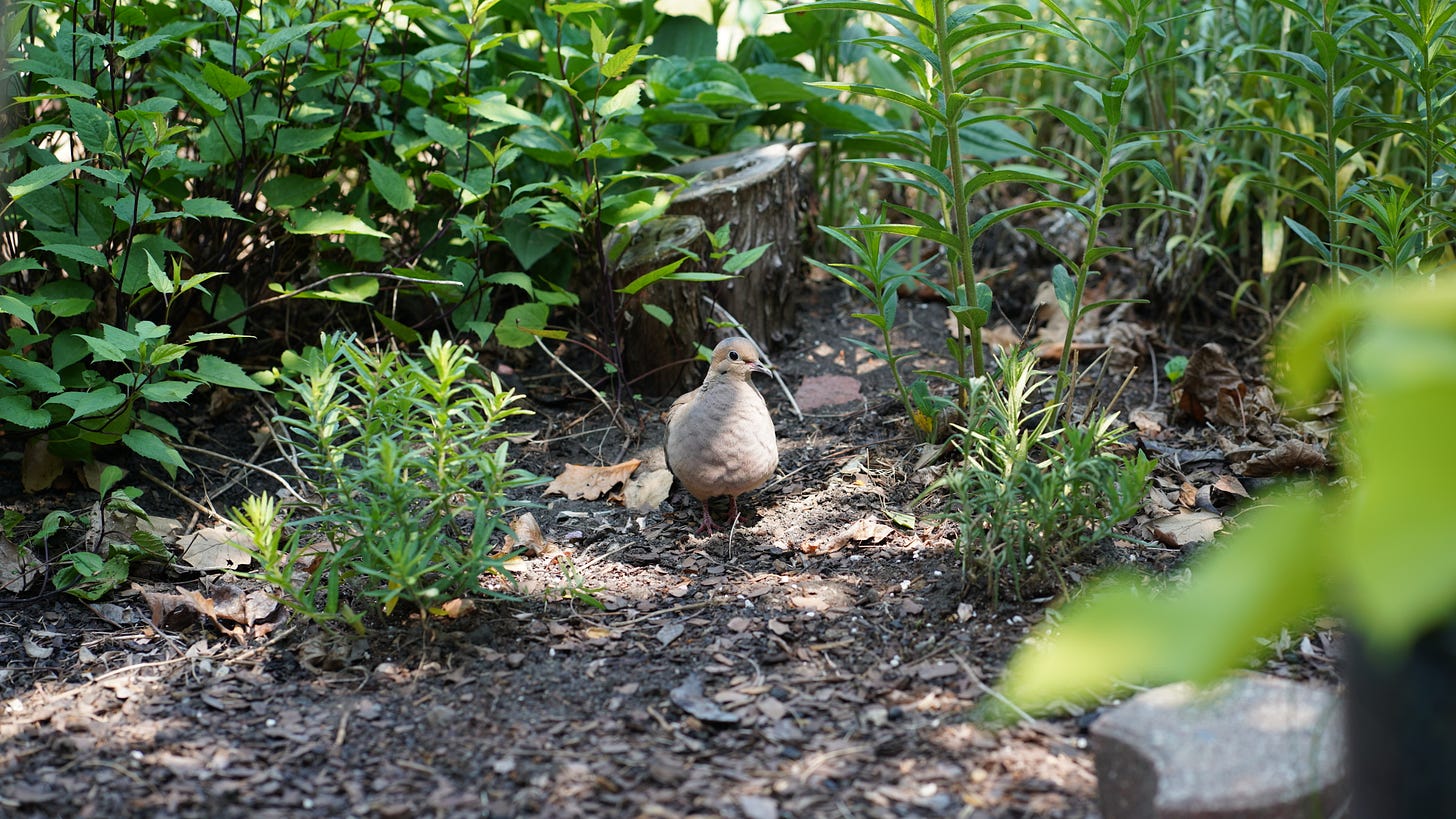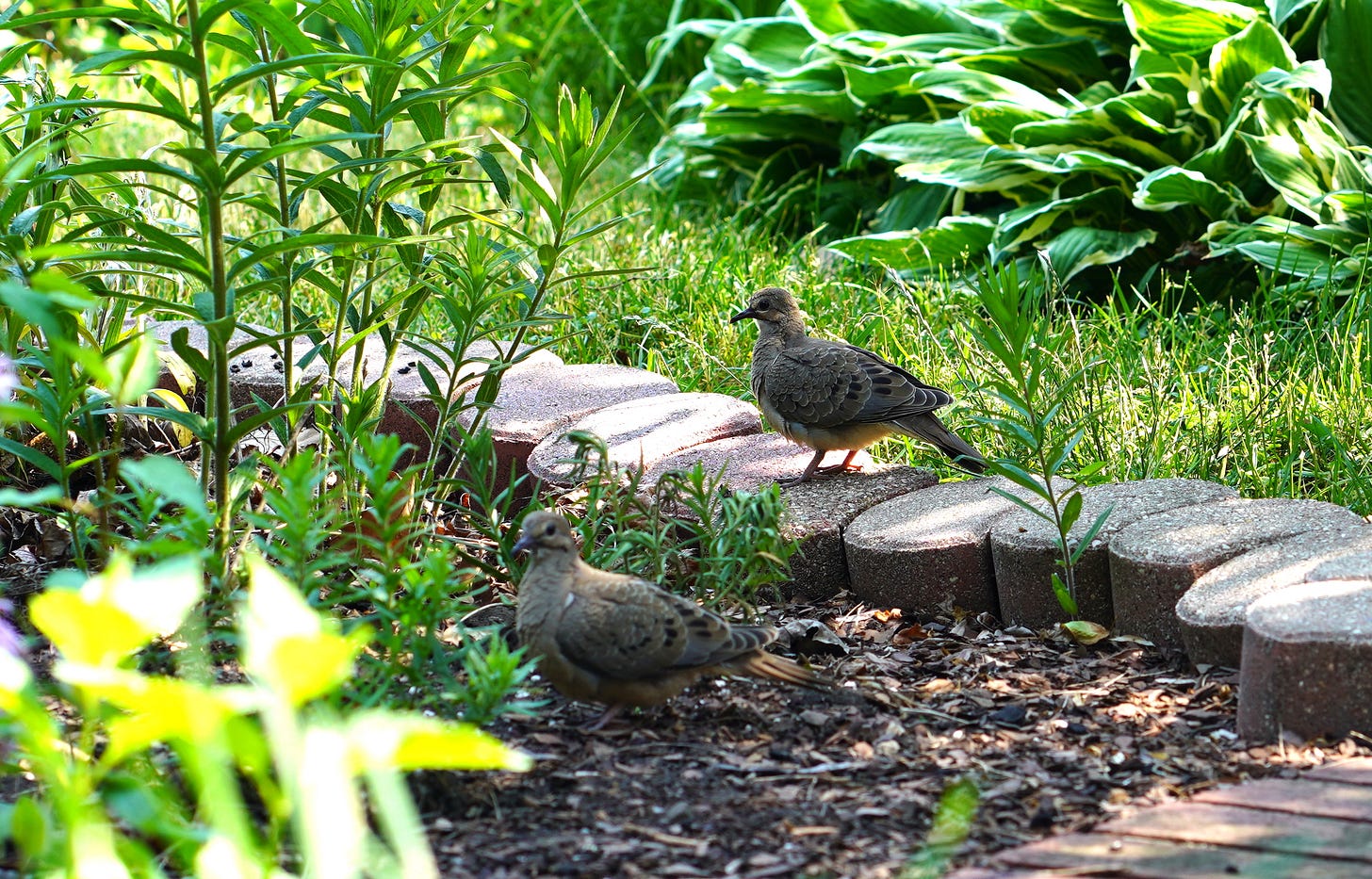Tales of a summer backyard
Mourning Doves, Baltimore Orioles, and House Wrens keep things interesting.
Starting in mid-June, a pair of juvenile Mourning Doves began hanging around the garden. It seemed they’d fledged from a nearby nest, though any signs of their nidification site remained elusive. It’s a good neighborhood for doves. Living along the lakefront for many years, we rarely saw Mourning Doves. There were plenty of Rock Pigeons. But very few of their more elegant cousins. It’s different inland a few miles. We also have one of the bigger *the biggest* colony of Eurasian Collared Doves in the city limits.
The juvenile doves, or squabs, were almost like garden ornaments, calm and relaxed amid the native plantings. Where adult Mourning Doves have smooth feathering, pinkish tones, and a few back and wing markings, these birds were a dull gray-brown with a more mottled look. They were also noticeably smaller in size than their parents, who typically lingered nearby.
With their soft cooing and halting movements, it can be easy to write off Mourning Doves as one of the more passive local species. However, the adult doves didn’t always take kindly to our proximity to the squabs, nor the presence of other birds. One day an American Robin was fending off a particularly aggressive Blue Jay (is there any other kind?). An adult Mourning Dove swooped in and took on *both* birds, clearing them away from the back yard to ensure the safety of the juveniles.
Having read Joel Greenberg’s masterpiece “A Feathered River Across the Sky: The Passenger Pigeon’s Flight to Extinction,” I knew that the Mourning Dove’s larger cousins fed their young something called crop milk. As incongruous as it sounds, dove and pigeon species do produce a sort of milk, a cottage cheese-like substance that is available to their young. That’s the case for the Mourning Dove, though I never observed juveniles consuming “milk” until it happened with the docile pair in our yard. The male or female adult—I’m not sure which, both sexes produce crop milk—landed next to the young ones and feeding commenced:
I haven’t seen the young ones since we returned from a week-long trip recently. I assume they’ve forged out on their own. There are still one or two doves, likely the adults, hanging around the powerlines or pecking at the remnants of mulberries in the street. Though Mourning Doves only lay two eggs at a time, it is possible that they’ll have another brood (or even two more) this season. In the meantime, we have another pair of young hanging around—two Eastern Cottontails—enjoying a patch of clover on our back lawn, and they are not bad replacements at all.
Baltimore Orioles revisited
You might recall that I finally got Baltimore Orioles to visit our feeder this spring. In case you're interested in doing the same, I wanted to clarify a few things about feeding these beautiful birds. There was a news story recently from central Wisconsin, about Ruby-throated Hummingbirds getting covered in grape jelly (for orioles). When it gets warm out, the jelly melts and it gets stuck to hummingbirds’ feathers. Experts suggest buying bird-safer jelly from an outlet like Wild Birds Unlimited. Jelly like the Smuckers that I used also has some non-natural ingredients that make it less safe for avian consumption. Another option is cutting up whole grapes and making them available for the orioles.
Additionally, just a reminder that jelly isn’t a staple of the Baltimore Oriole diet. It should mostly be used during spring migration but should stop being available during breeding season (now).
Feeding birds is fun, but it’s always worth a quick search to make sure to do so safely!
Wren and shrimpy?
House Wrens are denizens of back yards in summertime across much of North America. They take quickly to nest boxes. We have had one or two present since late April, though their behavior has been puzzling. Were they going to mate? Were we going to have little wren chicks in the yard?
The birds go into the nest box, come back out, go back in, sing (repeatedly), and then going back in again. When a second wren appears, there’s no sign of mating. Sometimes the first wren would chase off the second wren and vice versa. Other times, the second wren would go into the box and come right back out.
All About Birds has interesting info about House Wren nesting behavior:
Male House Wrens start building several nests at once in hopes of persuading a female to mate with him. Pairs typically break up by the end of each nesting season and choose new partners the next year. House Wrens are aggressive. Single males sometimes compete for females even after a pair has begun nesting. In about half of these contests the outsider succeeds in displacing his rival, at which point he usually discards any existing eggs or nestlings and begins a new family with the female.
Sexes look alike, so it is hard to tell what is going on. We have a front-row seat to this saga, so I’ll look forward to sharing an update once we have further insight.
If you liked this post, you also might like:
What I did this summer, aka neighborhood birding
Peter Gibbons: What would you do if you had a million dollars? Peter Gibbons: Nothing. Lawrence: Nothing, huh? Peter Gibbons: I'd relax, I would sit on my [back side] all day, I would do nothing. That’s a bit of dialog from the stellar 2001 workplace comedy “Office Space.” The main character, Peter Gibbons, a down-on-his-luck software developer, is having a…
SOSA, COMO and EGGOs: maybe birding shorthand should be a NOGO
When I’m out in the field, I still use a pencil and a notebook to keep track of what I see. It’s a little old-fashioned, sure. I jot down species mostly using banding code abbreviations, that generally take the first couple of letters of the words in a species’ name. For single-word species it’s the first four letters. I’ll buy a Moleskine for note-taki…







